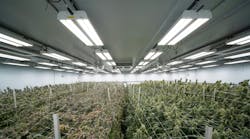A study by a Dutch university has shown that placing about a third of a greenhouse’s LED grow lights among high wire tomato crops rather than suspending all of them above the vines can increase the yield, according to lighting company GE Current, which supplied the fixtures.
Wageningen University & Research (WUR) compared the growth of about 20 trusses of two tomato varieties with another 20 trusses of the same two cultivars — Marinice and Santiana.
Researchers grew each over the same five month period, applying the same light intensity, duration, and red-heavy spectral content to both. It also kept other growing conditions such as water, nutrition, ambient temperature, and CO2 levels the same.
But in one group it used only toplights. In the other, it used 66% toplights while mounting the remaining 34% of the LED fixtures among mature leaves.
The tomatoes in the mixed-height lighting scheme “produced an average of 14% more fruit,” GE Current reported, while also noting that the two different groups exhibited no difference in quality or taste, as they both registered similar acidity and Brix (sugar) levels.
Get the latest in controlled environment agriculture thought leadership at the 2022 Resilient Harvests Conference. Register for the two-day November event.“Increasing the proportion of light delivered from intracanopy lighting and applying photons to the lower areas of the plant sparked a few changes of plant architecture and physiology,” WUR said in a report. “For example, the bottom leaves were 6% larger and able to process more CO2 in photosynthesis. These two changes contributed to more overall growth.”
WUR noticed “a 73% higher maximum photosynthetic capacity of the bottom leaves” in the intra-lighting setup than in the toplighting-only section.
The practice of placing lights among the leaves goes by various names. While GE Current refers to it as “intracanopy” lighting, rival Fluence — recently acquired by another competitor, Signify — has dubbed it “intercanopy” lighting. Signify refers to it as “interlighting.”
Semantics aside, horticultural LED lighting vendors and experts are increasingly advocating the method. Fluence introduced new intercanopy fixtures earlier this year.
GE Current — its full name is GE Current, a Daintree company — is hoping to explore the subject more with WUR, a life sciences university in the town of Wageningen in central Holland.
“We are currently discussing further potential collaboration with Wageningen University & Research to determine the most productive division of light energy between LED toplights and intracanopy lighting,” said GE Current horticultural scientist Hans Spalholz. “However, for now, the results at 34%…are extremely encouraging.”
Current said that the intracanopy lighting would benefit other high wire crops, such as cucumbers and bell peppers.
In the WUR study, the university used Current’s Arize Element L1000 toplight and its Arize Integral intracanopy lighting.
MARK HALPER is a contributing editor for LEDs Magazine, and an energy, technology, and business journalist ([email protected]).
For up-to-the-minute LED and SSL updates, follow us on Twitter. You’ll find curated content and commentary, as well as information on industry events, webcasts, and surveys on our LinkedIn page and our Facebook page.






